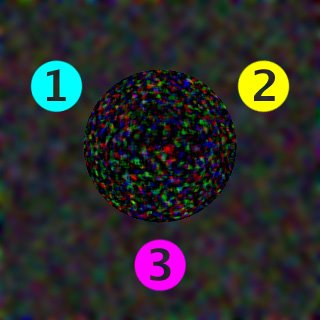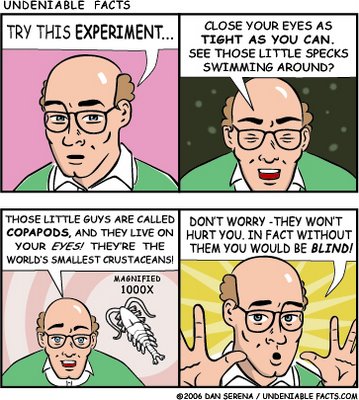It's Undeniable Friday! Every Friday, in addition to an odd little factoid, UndeniableFacts.com gives you a fun puzzle, illusion, or activity to enjoy and share.
Today: "Musical Circles, the Coronelli Effect"
This illusion was discovered in 1693 by the renowned Italian psychologist Vincenzo Coronelli while doing research for the Italian government on psychological weapons.

To experience the effect of this illusion, you must quickly look from colored circle to colored circle. First look at 1, then at 2, then at 3, and then back at 1 (repeat). Pause at each circle only long enough to read the number, and then move to the next one. You should begin to "hear" a part of Beethoven's 5th in your head. For most people the effect is not so strong as to be considered "hearing things", but is something like having a song "stuck in your head".
How it works: While the background and middle circle in this image may appear to be filled with random noise, they are in fact very carefully constructed patterns. An analogy would be to think of AM radio. In an AM signal, a "carrier" wave - that is a simple sine wave - is broadcast and is "modulated" - its strength altered - according to the signal being broadcast. This illusion works on a similar principle. As you trace your eyes from circle to circle, your eyes scan over the background, which is filled with a pattern that Coronelli dubbed "syncing noise".
Although you don't consciously see the specific features in the pattern, they stimulate your optic nerves, sending a signal to your brain which is very similar to the kind of information that the brain usually receives from your ears. Some of this signal gets to the auditory part of your brain which recognizes the pattern as sound. In this way the syncing noise can be thought of as a "carrier signal" for your brain. But while your brain recognizes it as a "sound signal", the signal only contains silence. That's where the circle in the middle comes in. The pattern in the circle is actually part of Beethoven's 5th specially encoded as a signal which "modulates" the syncing noise. Your brain's auditory cortex receives the syncing noise and the pattern in the middle circle (Coronelli called it the "phonopattern") simultaneously and and is tricked into partially believing that it is actually hearing Beethoven's 5th. As you repeatedly cycle around the circles, your eyes naturally try to scan the parts they haven't looked at yet. Thus, they slowly drift into the middle of the circle, giving you new data each time around.
Which leaves one last component which I haven't mentioned yet: the colored circles. Obviously you need a point to focus on for steps 1, 2, and 3, but the color of these circles is also very important. When you focus on each circle, it depletes the receptors in your eyes which perceive the color of that circle (which is why the circles are so bright, and is also why you have to pause for a moment on each one). This prevents you from picking up the parts of the signal which are that color, and so your brain isn't flooded with garbled information.
When Coronelli first created this illusion, he used layers of gelatin and dyes to create the patterns. He played a short melody on a violin which was attached to a metal container with the gelatin in it. The vibrations caused the gelatin to raise and lower at different points, and after it had gelled, Coronelli placed a piece of parchment gently on the gelatin. When he removed it, the parchment had a perfect visual representation of the sound. Coronelli had to do this with 12 dyes, playing the melody exactly the same way each time. It took him over one hundred tries, and nearly three months to get it right, and when he presented it to the Italian government, the King was not impressed. Coronelli was arrested and charges were trumped up against him, ending with his execution.
These days, a computer program can generate the illusion in a matter of minutes.
Labels: circles, coronelli, effect, illusion, musical, undeniable friday





